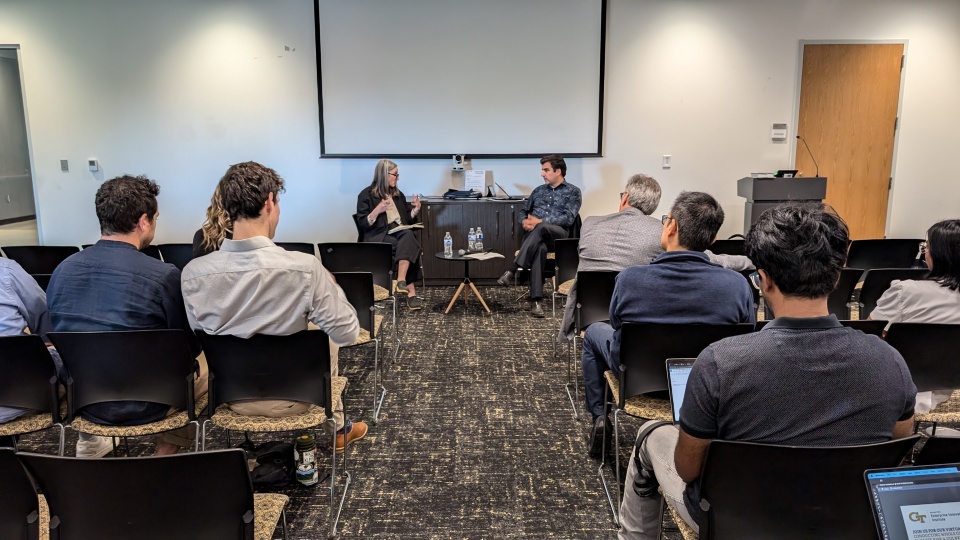In Georgia Tech Visit, Future of Conflict Expert Brings His Perspective on Modern Warfare

Jenna Jordan, left, associate professor and associate chair in the Sam Nunn School of International Affairs, talks with Tim Sweij, director of research at The Hague Centre for Strategic Studies and a senior research fellow at the Netherlands Defence Academy's War Studies Research Centre, during a visit to Georgia Tech on Oct. 8, 2024.
The conflict in Ukraine is showing the world a lot about the future of warfare, and it’s not all satellites and AI, conflict scholar Tim Sweijs told students and faculty during a recent Georgia Tech visit.
"The war in Ukraine has punctured the visions that portray future wars as being hybrid, liminal, or gray-zoned,” Sweijs said, referring to conflicts that fall in between peace and warfare. “We’re seeing over the past 30 months is a war of attrition with large armies stretched out over hundreds and hundreds of kilometers of battlefront."
Sweijs is director of research at The Hague Centre for Strategic Studies and a senior research fellow at the Netherlands Defence Academy's War Studies Research Centre. His talk was part of a series sponsored by the Nunn School of International Affairs focusing on the intersection of emerging technologies and their implications for conflict and statecraft.
Tracking how emerging technologies impact international security is a significant focus at the Nunn School, where scholars interested in everything from bioweapons to space policy are tracking how rapidly emerging technology will change how nations project their influence, including in war.
There’s no question emerging technologies are a factor in the Ukraine conflict, Sweijs says. Drones and artificial intelligence have certainly played their roles. However, Sweijs sees a convergence in old and new technologies and techniques that military leaders and policymakers should consider as they think about future military force structure and spending.
“I see super-empowered individuals with the power to turn off and on satellite access that can be used for targeting. I see a launching ground for the deployment of robots and semi-autonomous systems, or perhaps autonomous systems,” he said. “We see real-time intelligence derived from space assets. We see constellations of surveillance drones” among other coming innovations.
“So yes, there’s a lot to be said about the new technologies, but there’s also the old,” he said.
Adm. James “Sandy” Winnefeld, retired vice chairman of the U.S. Joint Chiefs of Staff and a distinguished professor of the practice in the Nunn School, also spoke at the session. He said the Ukraine conflict has shown the value of “small, smart things” such as drones and hand-held missile systems over traditional military assets such as tanks or helicopters.
Emerging technologies are just beginning to alter modern conflicts, he said. But he said that day is coming, and the U.S. should do more to prepare for it, especially when it comes to artificial intelligence, he said.
"AI is barely on the battlefield right now, but machine learning is becoming increasingly important in logistics, targeting, and real-time battlefield awareness. We are not yet seeing strategic breakthroughs, but that day is coming. It’s important that we start preparing for when AI becomes a major force in future conflicts,” he said.
The talk was supported by a generous gift from Bank of America.